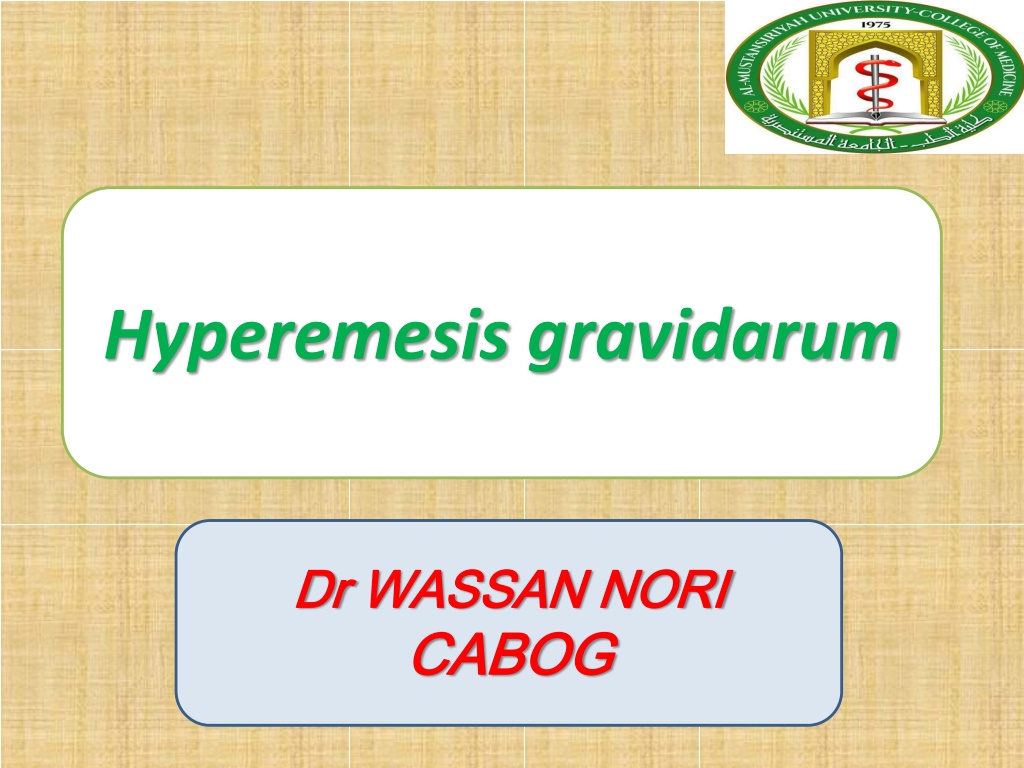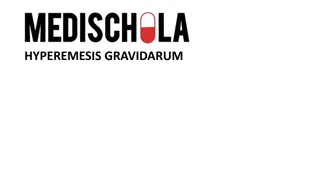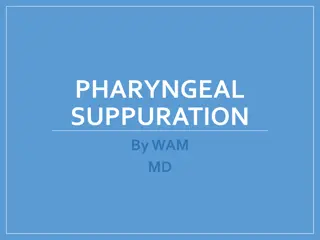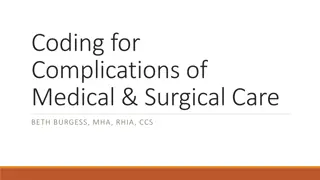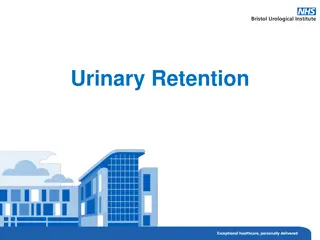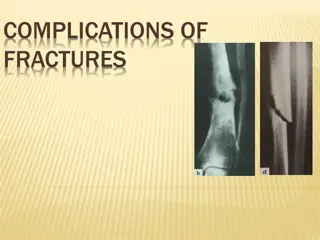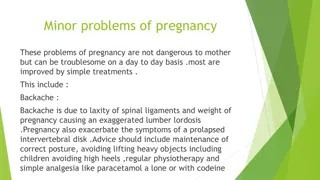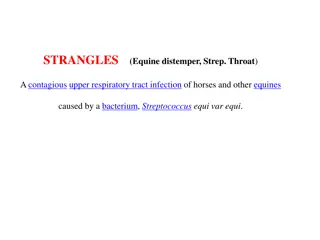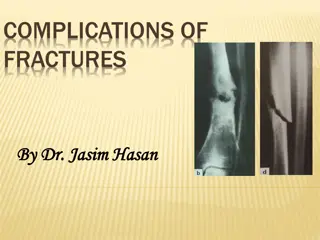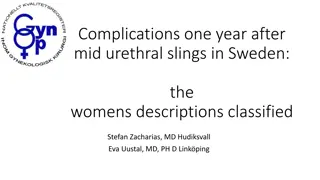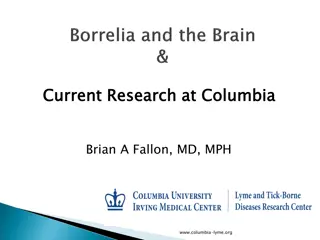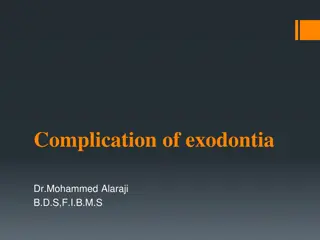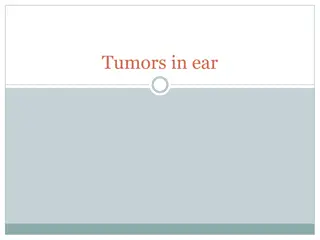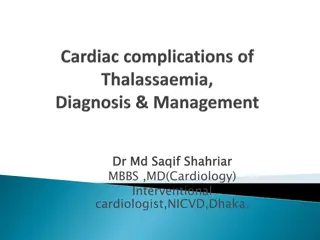Understanding Hyperemesis Gravidarum: Symptoms, Complications, and Management
Hyperemesis gravidarum is a severe condition in pregnancy characterized by intractable nausea and vomiting, resulting in fluid and electrolyte imbalances, nutritional disturbances, and physical and psychological debilitation. The exact cause is unknown, but factors like hormonal changes, genetics, and psychological components may play a role. Symptoms include excessive vomiting, dehydration, weight loss, and metabolic imbalances. Maternal complications can range from gastrointestinal issues to neurological disorders, while fetal complications may arise if maternal weight loss exceeds 10%. Management involves addressing symptoms, ensuring hydration, and monitoring for potential complications.
Download Presentation

Please find below an Image/Link to download the presentation.
The content on the website is provided AS IS for your information and personal use only. It may not be sold, licensed, or shared on other websites without obtaining consent from the author. Download presentation by click this link. If you encounter any issues during the download, it is possible that the publisher has removed the file from their server.
E N D
Presentation Transcript
Hyperemesis gravidarum Dr Dr WASSAN NORI WASSAN NORI CABOG CABOG
Hyperemesis gravidarum is a severe, intractable form of nausea and vomiting that causes imbalance of fluid and electrolytes, disturbs nutritional intake and metabolism, causes physical and psychological debilitation and is associated with adverse pregnancy outcome, including an increased risk of preterm birth and low birth weight babies
Incidence it affects 0.3 2 % of pregnancies, the aetiology is unknown and appears to be multifactorial. 1. Population incidences vary, and there appears to be an ethnic or familial predilection. 2. It appears to be related to high or rapidly rising serum levels of pregnancy-related hormones possibly: human chorionic gonadotropin (hCG) and estrogens 3. There are interrelated psychological components (more common in anxious women). 4. Other factors that increase the risk for admission include hyperthyroidism, previous molar pregnancy, diabetes, gastrointestinal illnesses, and asthma. 5. An association of H. pylori infection has been proposed
Signs and symptoms: Excessive nausea and vomiting, excessive salivation (ptylism) in 60%, dehydration (dry and coated tongue, delayed skin turgor, postural changes in blood pressure and pulse rate) significant weight loss, jaundice, metabolic acidosis
Maternal Complications: 1. Vomiting may be prolonged, frequent, and severe causing Mallory-Weiss tears bleeding, pneumothorax, pneumomediastinum and esophageal rupture. 2. Depression that could be a cause or an effect. 3. Wernickes encephalopathy: CNS dysfunction due to deficiency in thiamine B1 presents with apathy, confusion, ataxia and blindness. long-term sequelae are common and include blindness, convulsions and coma. A third of women have an abnormal electroencephalogram (EEG). 4. Various degrees of acute renal failure from dehydration are encountered that may require dialysis.
:5. Hypoprothrombinemiavitamin K deficiency causing maternal coagulopathy and fetal intracranial hemorrhage 6. Thromboembolism and hepatic failure 7. Central pontine mylenolysis, acute peripheral neuropathy and maternal death Fetal complication Outcome is generally good, however if there is maternal weight loss more than 10% then poor fetal outcome in form of preterm labour, fetal growth restriction and fetal death is expected
Diagnosis: A pregnant woman presents with excessive nausea and vomiting. The diagnosis of hyperemesis is by exclusion of other causes of nausea and vomiting which could be: (DDX) Gastrointestinal: peptic ulcer, gastroenteritis, gastro-esophageal reflux and pancreatitis. Genitourinary: pyrlonephritis, renal stone and leiomyoma red degeneration. Metabolic: diabetic ketoacidosis and hyperthyroidism. Neurological: tumours and meningitis Others: poisoning, psychological and fatty liver of pregnancy
Investigations: 1. Ultrasound to confirm the pregnancy and exclude twin and molar pregnancy. 2. GUE for ketones( which indicates dehydration) and infection 3. Complete blood count: hemoconcentration (raised PCV) 4. Renal function test: raised urea and creatinine 5. Liver function test: increased bilirubin and transaminases. 6. Thyroid function test: raised T4 and suppressed TSH 7. Raised serum amylase. 8. Electrolytes: decreased Na, K , Cl 9. Metabolic alkalosis
treatment 1. Psychological support and home environment changes. 2. Small liquid meals are better tolerated than solid, less nausea with protein meals than carb. and fat 3. Indications for admission: If vomiting persists after rehydration and failed outpatient management, severe dehydration, electrolyte abnormalities, acidosis, infection, significant wt loss and if there is doubt about the diagnosis. 4. Fluid therapy: ringer solution is a good choice, normal saline 1 L+ 20-40 mmol KCL 8-hourly. Dextrose is better to be avoided as it may precipitate Wernicke's encephalopathy. Continue the fluid until the patient can take oral fluid or no ketones in urine. .
5. Vitamine therapy: B6 10-30 mg per day is safe and reduces the nausea.Thiamine orally 25-50 mg tds or IV 100mg weekly 6. Anti-emetic therapy: are safe in pregnancy, antiemetics such as cyclizine 50mg , promethazine 25mg, chlorpromazine 10mg or metoclopramide 10mg are given orally or parenterally 2-3 times \ day. 7. Steroids: there is little evidence that treatment with glucocorticosteroids is effective. 8. Nutritional Support: in the small percentage of women who continue to have severe vomiting, consideration is given for enteral or parenteral nutrition
Thyroid disorders In pregnancy there is altered thyroid binding globulin as a result of increased estrogen which increases its synthesis, as a result there is increased level of total T3 and T4 but the free portion is unchanged. So it is important to measure the free T3 and T4 and to base the management on these levels, the lower limit of normal of free T4 is below that of non pregnant. There is iodine deficiency as a result of loss through increased GFR. This results in increased uptake by thyroid gland that results in goiter
Hyperthyroidism Causes: most of cases are due to Graves' disease which is an autoimmune disorder with high levels of circulating thyroid stimulating antibodies. Other causes (<5%) are: toxic nodule, thyroiditis, multinodular goiter, carcinoma and rarely trophoblastic disease. The diagnosis may be difficult to make in pregnancy because maternal tachycardia, wt loss, heart murmurs and heat intolerance are common symptoms in pregnancy. Women with well-treated disease rarely have maternal complicationsof pregnancy
, Poorly controlled hyperthyroidism is associated with several pregnancy complications, including: cardiac arrhythmias, maternal thyrotoxic crisis, miscarriage, gestational hypertension, pre- eclampsia, preterm labour, diarrhea, abdominal pain and psychosis. Thyroid stimulating antibody may cross the placenta and cause fetal hyperthyroidism and goiter which may obstruct labour. Other fetal complications are: fetal tachycardia, prematurity and intrauterine growth restriction. The risk of these complications is reduced if the disease is adequately controlled before delivery
Treatment: 1. Antithyroid drugs: 2. Beta blockers may be indicated to control the arrhythmias 3. Surgery is rarely indicated 4. Radioactive iodine is contraindicated because it completely obliterates the fetal thyroid gland.
Hypothyroidism It affects approximately 1% of pregnant women. Providing thyroxine replacement therapy is adequate, hypothyroidism is not associated with an adverse pregnancy outcome for the mother or fetus. An association between poorly controlled hypothyroidism and a variety of adverse outcomes, including: congenital abnormalities, hypertension, premature delivery, fetal growth restriction , placental abruption and post- partum haemorrhage. Overt hypothyroidism causes subfertility, and the presence of thyroid autoantibodies, even if the mother is euthyroid, is associated with an increased risk of miscarriage . Severe hypothyroidism affects the subsequent intelligence of the offspring of affected mothers with neurodevelopmental delay at the age of 7 9.
Causes : The commonest cause is iodine deficiency which may result in cretinism of the newborn as a result of congenital hypothyroidism; other is autoimmune hashimoto's thyroiditis. Treatment: Women with hypothyroidism should be given thyroxine replacement at a dose that ensures their thyroid function tests are normal with a FT4 at the upper end of the normal range appropriate for each trimester of pregnancy. Thyroxine is best taken on an empty stomach and 4 h apart from any iron or other supplements
Post-partum thyroiditis Post-partum thyroiditis is associated with the presence of thyroid anti peroxidase antibodies. The incidence varies between 2 and 16%. It is characterized by an initial hyperthyroid phase that classically occurs 1 3 months post-partum, followed by a hypothyroid phase, which usually resolves by 12 months after delivery. The hypothyroidism may require treatment with thyroxin, but treatment should be stopped after 1 year as many cases resolve. However, there is a risk of developing subsequent hypothyroidism in women who have had post-partum thyroiditis, so affected women should have their thyroid function checked regularly.
Pituitary disorders: For microadenoma the treatment is usually stopped during pregnancy, it may enlarge during pregnancy but rarely cause a problem, with frequent monitoring of visual field, if tumour enlarges then treatment is recommended. For macroadenoma (>1cm size) it is best to continue with dopamine agonist because the risk of tumour enlargement, there is no evidence that drugs are teratogenic.
Cushing syndrome Most females are infertile, if get pregnant then high incidence of preterm delivery and still birth. The diagnosis is difficult because the symptoms mimic normal pregnancy changes as striae, weight gain, weakness, hypertension and diabetes. Assay of plasma cortisol, CT, US, MRI are indicated
Addison disease Presents with exhaustion, hypotension, hypoglycemia and wt loss Occasionally may present with crisis which is treated with fluid and glucocorticoid Treatment: replacement with steroids should continue during pregnancy with parenteral therapy at time of stress such as labour
Phaeochromocytoma: Is rare presents with hypertensive crisis like preeclampsia, characteristic feature is paroxysmal hypertension, other features as headache, blurring of vision, anxiety and convulsion. Diagnosis: measurement of the level of catecholamines Treatment: alpha blockers and phentolamine, preferably delivery by caesarean section to avoid the sudden increase in catecholamines associated with delivery
